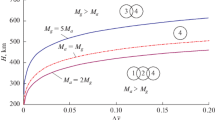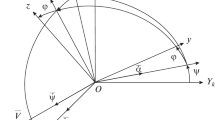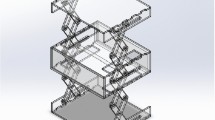Abstract
The motion of aerodynamically stabilized nanosatellites of the CubeSat design is studied. The features of the nanosatellites behavior in low orbits are conditioned both by the atmospheric effects and their own mass and inertial characteristics: the lifetime of nanosatellites is shorter, while the angular acceleration generated by the aerodynamic moment is much higher as compared with big satellites having large mass. CubeSats may experience resonance modes of motion caused by the shape factor of a rectangular parallelepiped. In addition, the existing commercial CubeSat deployers often generate large initial angular velocities that are random in nature. The conditions that cause the specific features of the CubeSat motion are considered and analyzed. A probabilistic approach to choosing their mass and inertial characteristics is proposed. The problems of motion stabilization are studied, and recommendations are formulated on the design of aerodynamically stabilized CubeSats with a passive/active magnetic damping system.
Similar content being viewed by others
References
Kirillin, A., Belokonov, I., Timbai, I., Kramlikh, A., Melnik, M., Ustiugov, E., Egorov, A., and Shafran, S., SSAU nanosatellite project for the navigation and control technologies demonstration, Procedia Engineering, 2015, volume 104, pp. 97–106.
Shakhmatov, E., Belokonov, I., Timbai, I., Ustiugov, E., Nikitin, A., and Shafran, S., SSAU project of the nanosatellite SamSat-QB50 for monitoring the Earth’s thermosphere parameters, Procedia Engineering, 2015, volume 104, pp. 139–146.
Beletskii, V.V., Dvizhenie iskusstvennogo sputnika otnositel’no tsentra mass (Motion of an Artificial Satellite Relative to the Center of Mass), Moscow: Nauka, 1965.
GOST 4401-81 Atmosfera standartnaya. Parametry. Vvedenie (Standard atmosphere. Parameters. Introduction) 1981-02-27. Moscow: Izvatel’stvo standartov, 1981.
Belokonov, I.V., Storozh, A.D., and Timbay, I.A., Modes of motion of Soyuz orbital stage after payload separation at carrying out of the short-term research experiments, Advances in the Astronautical Sciences, 2012, vol. 145, pp. 99–107.
Belokonov, I., Kramlikh, A., Timbai, I., and Lagno, O., Problems of satellite navigation and communications for nanosatellites launched as piggyback payload from the orbital stage of carrier rockets, Proc. 21st Saint Petersburg International Conference on Integrated Navigation Systems, 2014, pp. 407–415.
Belokonov, I.V., Kramlikh, A.V., and Timbai, I.A., Low-orbital transformable nanosatellite: Research of the dynamics and possibilities of navigational and communication problems solving for passive aerodynamicstabilization, Advances in the Astronautical Sciences, 2015, vol. 153, pp. 383–397.
Yudintsev, V.V., The dynamics of the CubeSat separation from the deployer, Polet. Obshcherossiiskii nauchno-tekhnicheskii zhurnal, 2015, nos. 8–9, pp. 10–15.
Yaroshevskii, V.A., Dvizhenie neupravlyaemogo tela v atmosphere (Motion of an Uncontrollable Body in the Atmosphere, Moscow: Mashinostroenie, 1978.
Aslanov, V.S. and Boiko, V.V., Nonlinear resonant motion of an asymmetrical spacecraft in the atmosphere, Cosmic Research, 1985, vol. 23(3), pp. 341–347.
Zabolotnov, Yu.M., Lyubimov, V.V., Application of the Method Integral of Manifolds for Construction of resonant Curves for the Problem of Spacecraft Entry into the Atmosphere, 2003, Cosmic Research, vol. 41 (5), pp. 453–459.
Platus, D.H., Angle of attack convergence windward meridian rotation rate of rolling re-entry vehicles, AIAA Journal, vol.7, no. 12, 1969, pp. 2324–2330.
Aslanov, V.S., Determination of the amplitude of three-dimensional oscillations of a ballistic vehicle with a small asymmetry during atmospheric entry, 1980, Cosmic Research, vol. 18 (2), pp. 141–146.
Bogolyubov, N.N. and Mitropol’skii, Yu.A., Asimptoticheskie metody v teorii nelineinykh kolebanii (Asymptotic Methods in the Theory of Nonlinear Oscillations), Moscow: Nauka, 1974.
Rawashdeh, S.A. and Lumpp, Jr., J. E. et al., Aerodynamic stability for CubeSats at ISS orbit, JoSS, 2013, vol. 2, no. 1, pp. 85–104.
Belokonov, I. and Timbai, I., The selection of the design parameters of the aerodynamically stabilized nanosatellite of the CubeSat standard, Procedia Engineering, 2015, volume 104, pp. 88–96.
Belokonov, I., Timbai, I., and Ustyugov, E.V., Eurasian patent for invention (21) 201400132 (13) A1, Method for aerodynamic stabilization of a Cubesat and the device for its implementation, 30.07.2015.
Ovchinnikov, M.Yu., Pen’kov, V.I., Roldugin, D.S., and Ivanov, D.S., Magnitnye sistemy orientatsii malykh sputnikov (Magnetic Attitude Control Systems of Small Satellites), Moscow: IPM im. M.V. Keldysha, 2016.
https://doi.org/gomspace.com/Shop/subsystems/solar-panels/p110-solar-panel.aspx.
Stickler, A.C. and Alfriend, K.T., Elementary magnetic attitude control system, Journal of Spacecraft and Rockets, 1976, vol. 13, no. 5, pp. 282–287.
Stickler, A.C., A Magnetic Control System for Attitude Acquisition, Ithaco, Inc., Rep. N 90345, 1972.
Kramlikh, A.V., Melnik, M.E., and Nikolaev, P.N., Attitude determination and stabilization algorithms of the SamSat-218D nanosatellite, Proc. 23rd Saint Petersburg International Conference on Integrated Navigation Systems, 2016, pp. 366–372.
Ovchinnikov, M.Yu., Ilyin, A.A., Kupriyanova, N.V., Pen’kov, V.I., and Selivanov A.S. Attitude dynamics of the first Russian nanosatellite TNS-0, Acta Astronautica, 2007, vol. 61, Is. 1–6, pp. 277–285.
Ovchinnikov, M. Attitude dynamics of a small-sized satellite equipped with hysteresis damper, Advances in the Astronautical Sciences, 2012, vol. 145, pp. 311–330.
Belokonov, I.V., Ivanov, D.S., Ovchinnikov, M.Yu., and Pen’kov, V.I., A system for damping the angular motion of the SamSat-QB50 nanosatellite, Preprint of the Keldysh Institute of Applied Mathematics, Moscow, 2015, no. 59, 28 p.
Author information
Authors and Affiliations
Corresponding author
Additional information
Original Russian Text © I.V. Belokonov, I.A. Timbai, P.N. Nikolaev, 2018, published in Giroskopiya i Navigatsiya, 2018, No. 3, pp. 61–91.
Rights and permissions
About this article
Cite this article
Belokonov, I.V., Timbai, I.A. & Nikolaev, P.N. Analysis and Synthesis of Motion of Aerodynamically Stabilized Nanosatellites of the CubeSat Design. Gyroscopy Navig. 9, 287–300 (2018). https://doi.org/10.1134/S2075108718040028
Received:
Published:
Issue Date:
DOI: https://doi.org/10.1134/S2075108718040028




